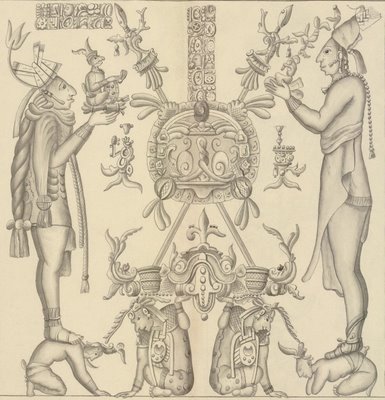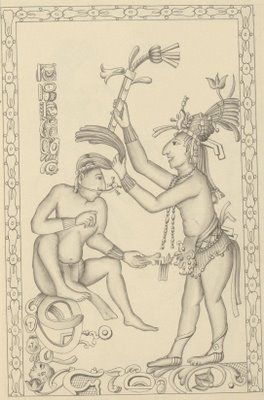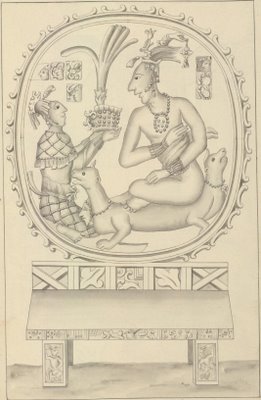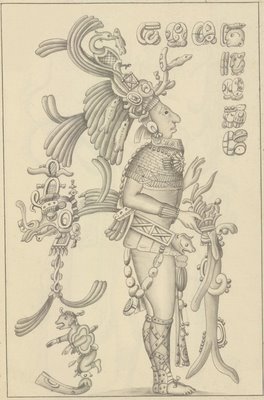"It is by no means improbable that these fantastic forms, and others equally whimsical, were the delineations of some of their deities, to whom they paid an idolatrous worship, consistent with their false belief and barbarous customs."










[click to enlarge]
Palenque, in the far southern Chiapas region of Mexico [map] (formerly part of Guatemala), was a significant city-state of the Mayan civilization. Although the site was already an important centre from around 400AD, the palace-topped pyramid and nearby temple structures [Mesoweb Palenque resources] weren't built until the 7th century. The buildings were mysteriously abandoned with the decline of the Mayan culture in the 9th century. [Theories as to the cause for this range from soil exhaustion to disease to invasion to natural disaster to trade route collapse to...]
The forest had overgrown Palenque by the time the first European visited in 1567. But little interest was shown in the site again until the 1770s when the military governor of Guatemala received a report which must have piqued his interest. He sent a party to investigate further in 1784, led by Colonel Antonio Del Rio and accompanied by the artist Ricardo Almendáriz. Despite the damage they caused to some buildings (and pillaging of relics to send to Spain), the team made a reasonably thorough survey of the site and Almendáriz was able to sketch 30 ink/ink wash drawings of the temple and palace bas reliefs to accompany the report of Del Rio.
From then on things get very confused - a number of different works were published during the next few decades and Del Rio's report apparently lay dormant for some reason. But the drawings themselves (the originals have only been discovered in private hands in the recent past) were published alone in Mexico in 1787 as: 'Coleccion de Estampas Copiadas de las Figuras Originales, que de Medio, y Baxo Relieve, Se Manifiestan, en Estucos y Piedras, en Varios Edificios de la Poblacion Antigua Nuevamente Descubierta en las Immediaciones del Pueblo Del Palenque', which is online in its entirety at the Library of Congress. {64 page book, no thumbnails, giant sizes available, illustration every 2nd page mostly} [The first european publication of a Palenque drawing was in a work by Humboldt in 1810, posted previously]
We must thank the devil for this. It was while searching for information about the demonologist Martin Del Rio the other day that I happened upon this exquisite series. I spent a lot of time cleaning up the background artifact in the images above, some of which are details. If there was a 'find of the month category', I think this book would be a pretty good bet for mine.
"There is no difficulty in publishing Tom Thumb -- or any thing else -- when we are disposed; and yet all America cannot furnish sufficient encouragement to publish a work on the greatest, yes, absolutely the greatest wonder in the world, discovered within her own borders! Well indeed should we deserve the scorpion lash of foreign Trollopes, if this were so."And with such admonishment, Dr. Pablo Felix Cabrera arranged to translate and publish the Del Rio document with third hand copies of the illustrations in London in 1822. The english text of Del Rio's report is published on this Oliver Cowdry website (it's not very long) together with a lot of Cabrera balderdash - he imagines a Phoenecian origin to the civilizations of America - but followed by a useful timeline with respect to the convoluted publishing/expedition history surrounding Palenque. Mormons figure prominently.
The Palenque Round Table Series in the Pre-Columbian Art Research Institute Journal .
No comments:
Post a Comment
Comments are all moderated so don't waste your time spamming: they will never show up.
If you include ANY links that aren't pertinent to the blog post or discussion they will be deleted and a rash will break out in your underwear.
Also: please play the ball and not the person.
Note: only a member of this blog may post a comment.